

Henry Ford - Biography, Inventions & Assembly Line - HISTORY. While working as an engineer for the Edison Illuminating Company in Detroit, Henry Ford (1863-1947) built his first gasoline-powered horseless carriage, the Quadricycle, in the shed behind his home.
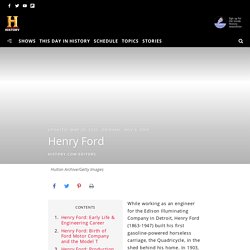
In 1903, he established the Ford Motor Company, and five years later the company rolled out the first Model T. In order to meet overwhelming demand for the revolutionary vehicle, Ford introduced revolutionary new mass-production methods, including large production plants, the use of standardized, interchangeable parts and, in 1913, the world’s first moving assembly line for cars. Henry Ford - Visionaries on Innovation. His Early Life as an Inventor Henry Ford did not invent the automobile.

He didn’t even invent the assembly line. But more than any other single individual, he was responsible for transforming the automobile from an invention of unknown utility into an innovation that profoundly shaped the 20th century and continues to affect our lives today. The Life of Henry Ford. July 30, 1863 Henry Ford is born on a farm to William and Mary Ford in Springwells Township, Michigan, located nine miles outside of Detroit.
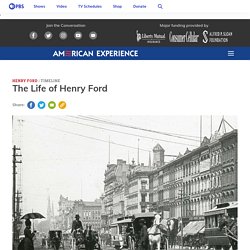
December 1879 Henry Ford leaves his family farm to pursue his interest in machinery in Detroit. One of his first jobs is at the Flowers Brothers Machine Shop where, for a salary of $2.50 a week, he shapes brass valves on a milling machine. April 11, 1888 On her 22nd birthday, Clara Bryant of Greenfield Township marries Henry Ford. Bryant grew up on a farm a few miles northeast of the Ford homestead. The Life of Henry Ford - Model T, Assembly Line 40470 HD.
How Ford Built America - The Man Behind The Automobile. Henry Ford. Christopher Sholes. Christopher Sholes Typewriter. Looking at Artifacts, Thinking About HistoryBy Steven Lubar and Kathleen Kendrick Start | Artifacts Tell their Own Stories | Artifacts Connect People | Artifacts Mean Many ThingsArtifacts Capture a Moment | Artifacts Reflect Changes | Telling Many Stories Artifacts reflect changes.
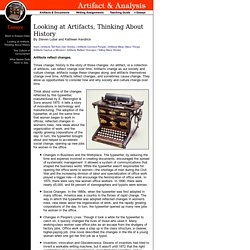
Edwin L. Drake. Who Made America? Oil Drilling Dogged persistence led this man to drill -- and drill -- and drill, seeking oil deposits.
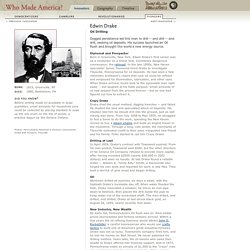
His success launched an Oil Rush and brought the world a new energy source. How Thomas Edison Changed The World - Reactions. Who Made America? The Science of Innovation The "Wizard of Menlo Park" brought the world electric light, recorded music, and the movies, among other things, and turned innovation into a science by inventing the research laboratory.
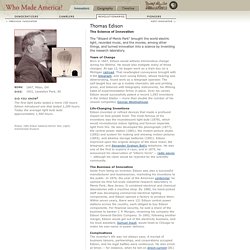
Years of Change Born in 1847, Edison would witness tremendous change during his lifetime. He would also instigate many of those changes. At age 12, he began work as a train boy on a Michigan railroad. That newfangled conveyance brought with it the telegraph, and soon young Edison, whose hearing was deteriorating, found work as a telegraph operator. Thomas Edison - Inventions, Patents & Biography - HISTORY. In his 84 years, Thomas Edison acquired a record number of 1,093 patents (singly or jointly) and was the driving force behind such innovations as the phonograph, the incandescent light bulb and one of the earliest motion picture cameras.
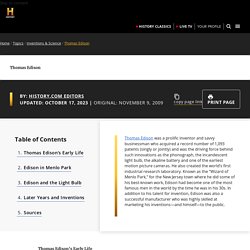
He also created the world’s first industrial research laboratory. Known as the “Wizard of Menlo Park,” for the New Jersey town where he did some of his best-known work, Edison had become one of the most famous men in the world by the time he was in his 30s. Samuel Gompers. Introduction - Samuel Gompers: Topics in Chronicling America. John D. Rockefeller. Biography: John D. Rockefeller, Senior. Youth John D.
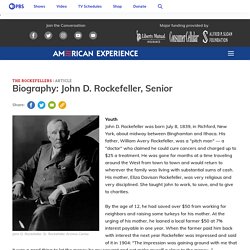
Rockefeller was born July 8, 1839, in Richford, New York, about midway between Binghamton and Ithaca. His father, William Avery Rockefeller, was a "pitch man" — a "doctor" who claimed he could cure cancers and charged up to $25 a treatment. Andrew Carnegie. The Duty of Administering Surplus Wealth for the Good of the People: Andrew Carnegie’s Legacy. Andrew Carnegie. Biography >> EntrepreneursOccupation: EntrepreneurBorn: November 25, 1835 in Dunfermline, ScotlandDied: August 11, 1919 in Lenox, MassachusettsBest known for: Becoming wealthy from the steel business, giving his wealth to charitiesNickname: Patron Saint of Libraries Andrew Carnegie by Theodore C.
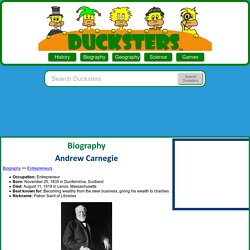
Marceau Biography: Where did Andrew Carnegie grow up? Andrew Carnegie was born on November 25, 1835 in Dunfermline, Scotland. Rise of Cornelius Vanderbilt. Cornelius Vanderbilt - Industry, Railroad & Facts - Biography. Cornelius Vanderbilt was a famous industrialist who worked in railroads and shipping.
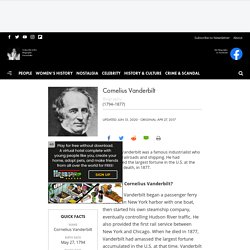
He had accumulated the largest fortune in the U.S. at the time of his death, in 1877. Who Was Cornelius Vanderbilt? Cornelius Vanderbilt began a passenger ferry business in New York harbor with one boat, then started his own steamship company, eventually controlling Hudson River traffic. He also provided the first rail service between New York and Chicago.
Henry Bessemer. Biography, Inventions, & Facts. Henry Bessemer, in full Sir Henry Bessemer, (born January 19, 1813, Charlton, Hertfordshire, England—died March 15, 1898, London), inventor and engineer who developed the first process for manufacturing steel inexpensively (1856), leading to the development of the Bessemer converter. He was knighted in 1879. Read More on This Topic steel: Bessemer steel Bulk steel production was made possible by Henry Bessemer in 1855, when he obtained British patents for a pneumatic steelmaking... Bessemer was the son of an engineer and typefounder. Alexander Graham Bell. Alexander Graham Bell. Edinburgh, Scotland; March 1847 Alexander Graham Bell is most well known for inventing the telephone. He came to the U.S as a teacher of the deaf, and conceived the idea of "electronic speech" while visiting his hearing-impaired mother in Canada.
This led him to invent the microphone and later the "electrical speech machine" -- his name for the first telephone. Bell was born in Edinburgh, Scotland on March 3, 1847.